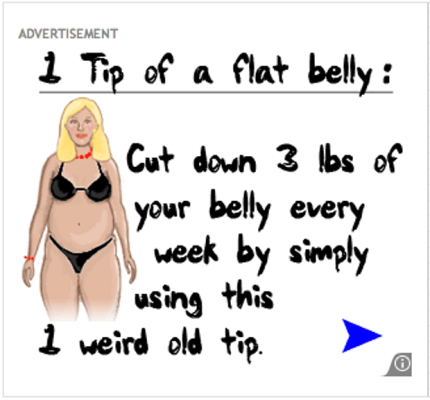I installed Adblock on my computer the other week. I’m well aware that this opens me up to charges of hypocrisy, given that online advertising is an essential part of how I earn a living – both in my day job, where we use advertising to get customers, and in my spare time business where I make money from adverts on my own websites. If everybody installed Adblock and used it in full, both of those would suffer considerably.
For that reason, I’ve made a point of setting Adblock to be disabled by default, and only enable it for specific websites. The websites that I enable it for (and it is still only a small proportion of those I visit regularly) are those which have egregiously intrusive advertising.

This isn’t actually an ad. It’s just a screenshot of one.
In particular, I enable Adblock on sites which have adverts that autoplay audio, that overlays the content of the page in any way, or that cause the content of the page to move, reflow or reformat after it has initially loaded.
I’m less bothered about autoplaying video, so long as it’s contained within a predefined border of an advert that doesn’t otherwise intrude into the rest of the page. But autoplay audio is a complete no-no. Do that, and it’s an immediate block. It’s also an immediate block if an advert causes the content of a page to shift or reflow after I’ve started reading it. Which is why I no longer see adverts on The Guardian’s website, for example.
One annoying form of advert in particular seems now to have become endemic on newspaper websites. It’s the one which doesn’t seem to be there to begin with, but then suddenly appears in the middle of the content as you scroll down. I’m sure you’ve all seen them. I’m equally sure that you all, like me, hate them. As it happens, they were mentioned in the Feedback section of The Times today:
I really don’t like the pop-up video adverts in the middle of articles on your website,” wrote AC Ruston. “There’s even one in the guidance on how to complain, for heaven’s sake. They’re an annoying distraction, and in some articles they are totally inappropriate.”
This complaint was followed by several others, and ended with an admission by the newspaper that using them was wrong:
We got the message and, as it happens, we agree. Advertisements shouldn’t interfere with the enjoyment of reading a newspaper or a website. We’ve asked the advertising department to remove this campaign.
Now, it’s easy to argue that The Times doesn’t need to use them, because, unlike most newspaper websites, it is subscription only. So advertising income is an add-on, and a fairly trivial one at that (since the paywall keeps most people out to begin with, and hence makes adverts far less valuable as the number of viewers is tiny by comparison with other national newspaper websites). Other newspapers, it can be argued, really need the advertising revenue.
The challenge of paying for free content has always been there. Research shows that up to 80% of users are unwilling even to consider paying for content. But even the 20% who are theoretically willing to pay rarely do, in practice. Traffic to The Times’ website now is less than a tenth of what it was before the paywall. News UK, owner of The Times, has backtracked on a similar “solid paywall” on the Sun’s website following an equally drastic drop in traffic. For news websites in particular, social media is an important driver of traffic – but there’s no point sharing a link to a story that most of your friends or followers can’t read.
The failure of pure subscription based models means that advertising is always going to be a key revenue source for the vast majority of websites. So maximising that revenue is important, and if another form of advert comes along which pays more – which these in-content video ads certainly do – then using them is very attractive.
If my experience, though, and that of the contributors to the Feedback column of the Times, is anything to go by, these adverts are almost universally disliked. And it isn’t a big step from disliking the adverts to finding a way of blocking them.
Unsurprisingly, use of adblockers has grown significantly over the past few years. Reliable statistics are hard to come by, but some estimates suggest that usage increased by nearly 70% between 2013 and 2014, with anything from 5% to 50% of ads blocked, depending on the website.
That’s a problem. It’s a very real problem. And it isn’t just a problem for websites which have excessively intrusive ads. Because when people install adblocking systems, they are quite likely to just accept the default of blocking all adverts, everywhere. Which means is that sites which don’t have don’t have intrusive adverts – which don’t autoplay audio, or relocate/obscure content – get their adverts blocked as well.
If the trend towards more and more intrusive adverts continues, therefore, the websites which use them will end up killing the golden goose that they rely on. And in turn take down the advert-supported economy of millions upon millions of small-scale websites which don’t have the resources to find alternative income. If that happens, it won’t just be those of us who rely on the advertising economy who will suffer. It will be every web user.
